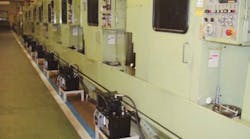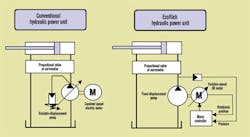Hydraulics once ruled the machine tool world. Because of its wide speed range, precise controlability, and high power density, hydraulics was the technology of choice for the majority power and control applications. But when variable-speed electromechanical drives came into their own, hydraulics was relegated to clamping and other applications where high forces inherent to hydraulics still prevail.
New technology, however, has given a big boost to energy efficiency of hydraulics. Hydraulic systems already make extensive use of pressure compensation and load sensing that save energy by controlling a variable-displacement pump to match pump output to energy requirements of the machine. However, in applications where relatively long dwell periods occur, hydraulic systems still consume substantial energy even though no work is being performed.
For example, a standard electric induction motor will consume at least 30% of full-load current running at no load — even if nothing is connected to its output shaft. Throw a hydraulic pump simply maintaining pilot pressure into the mix, and current draw could approach 50% of full load.
Big opportunity for savings
Depending on the equipment and how it’s used, hydraulics on a typical machine accounts for 45% to 60% of the machine’s total electrical consumption. A typical hydraulic power unit (HPU) is driven by a constant-speed electric motor running at 1800 rpm that may be up to 97% efficient when fully loaded. However, when the hydraulic system is in standby, with none of the actuators moving, with or without the pressure maintained, an electric motor consumes 40% to 50% of full load current. The efficiency of the hydraulic pump really doesn’t come into play; you can operate just the motor without a hydraulic pump attached and still see a power draw of 35%-45% of full-load current.
Officials at Daikin Industries Ltd., Osaka, Japan, observed this fact and developed the first HPU to dramatically reduce motor speed during standby modes. The result is an approximate energy savings of 50% — and the longer the dwell periods, the greater the energy savings. Currently, this type of unit is being use in a variety of industrial equipment.
Daikin developed this technology for its EcoRich hydraulic power units. By completely stopping hydraulic motor idling while maintaining pressure, these units have reduced HPU energy consumption during operation by 95%.
Technology behind the concept
Doing away with the standard induction motor and powering the pump through a variable-speed inverter drive causes the HPU to pump only as much fluid needed to maintain pressure. Machine tool manufacturers such as Mazak, Matsuura, Mitsui Seiki, Okuma, Kuraki, and Mori Seiki use hydraulic pumps powered by inverter drives on some of their new equiment. In fact, about one-third of the equipment built in the Japanese machine tool industry uses some version of the technology.
The EcoRich system’s operation is relatively simple. It uses an interior permanent magnet (IPM) switched-reluctance motor that produces high torque and exhibits low inertia. It operates somewhat like a stepper motor, in that torque can be controlled along angular positions within a rotation. It is driven through a variable-speed drive similar to a frequency inverter.
The IPM motor uses rare-earth permanent magnets deeply positioned within its rotor to generate both magnet torque and reluctance torque. This electromagnetic structure attains high torque, high efficiency, and low heat generation and effectively results in higher torque with lower current, even at low speeds.
The EcoRich system combines an IPM motor and inverter drive system with a tandem pump to create an HPU that automatically controls the pump depending on the load pressure during operation, standby, and pressure maintenance. For example, during pressure maintenance, the motor runs at minimum power to operate only the small pump to maintain pilot pressure. The HPU also performs advanced features such as multi-level pressure, flow volume control, and shockless control to simplify hydraulic circuitry.
The unit’s inverter technology attempts to always maintain a set pressure. The controller slows the motor to 400 rpm — fast enough to maintain line pressure. As soon as a valve opens downstream, a pressure transducer in the pump detects the pressure change, then the control ramps the motor speed up in less than 0.1 sec to maintain pressure, then slows back down to minimum speed. The pump also contains a rotary encoder, so the control constantly monitors pump speed and pressure. System software uses these data to determine output flow.
The pump’s inverter technology saves energy by keeping line pressure constant and minimizing the speed of the electric motor. Because the motor isn’t always running at 1800 rpm, the system generates less heat. The technology also allows advanced performance features, such as multi-level pressure, ow volume control, and shockless control that simplify the hydraulic circuits.
Additional benefits
By using software and closed-loop controls to match electrical consumption to hydraulic power output, the EcoRich system provides additional benefits, such as:
• HPUs operate at temperatures just above ambient, so heat exchangers and associated components are not needed,
• reservoirs are much smaller than with conventional HPUs, so less hydraulic fluid is needed,
• quiet operation — 68 dBA or less,
• consistently low heat generation, whether hydraulic system runs in standby mode or continuously at full load,
• hydraulic fluid lasts three times longer because it remains at low temperture, so less oxidation and other degradation occurs,
• because hydraulic oil lasts longer, maintenance and disposal costs are lowered,
• lower CO2 emissions than with conventional HPUs, and
• lower heat generation reduces cooling requirements of air-conditioned plants.
EcoRich hydraulic power units are available in the US from All World Machinery, Harvard, Ill. For more inforation, call (815) 943-01208, or visit www.allworldmachinery.com.



